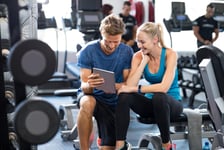Are your shoulders and necks getting tense? This stress is especially true for those who spend a lot of time on the computer. Many of us get tense in the shoulders, neck, and jaw—nine-to-fivers and mom entrepreneurs alike. Whether you are in an office at a desk or running errands, everyday activities like texting, driving, or even sleeping can contribute to a stiff neck. When was the last time you really stretched your fingers and forearms?
Related reading time: 4 minutes
One Person Yoga Poses—Easy Enough to Do at Work
These yoga exercises are made for one person to practice at work, at a desk, at home, or any time your notice tension creeping into your shoulders. Practicing these regularly will help to reverse tightness from hunching, typing, and gripping. Remember always to breathe deeply and try to soften into the stretch, not force it.
Yoga Sequence: Shoulder Stretch
This stretch is based on the rehabilitation exercise of Proprioceptive Neuromuscular Facilitation (PNF), which is often used in sports training and physical therapy. PNF involves contracting a muscle, then completely relaxing, and then gently stretching it further. The idea is that by first applying force and then total release, the eventual stretch will go deeper. "PNF is as close as we've come to scientific stretching," says San Francisco Ballet’s physical therapist Michael Leslie.

How to do a yoga stretch:
Bring one arm horizontally across your chest. Hold it in the crook of your opposite arm.
Apply pressure. Push your extended arm strongly into your bent arm and resist with your bent arm.
Completely relax. Let your extended arm go limp, resting in the crook of your bent arm.
Stretch. Gently take your straight arm across your body to stretch your shoulder. If it feels alright on your shoulder, take your bent arm and put your hand behind your head to deepen the stretch.
Yoga Sequence: Oblique Stretch
The oblique stretch delivers a triple benefit—extending and arching the torso relieves spinal compression; opening the shoulder counteracts hunching forward over a desk; stretching the fingers back remedies cramps in the hands.
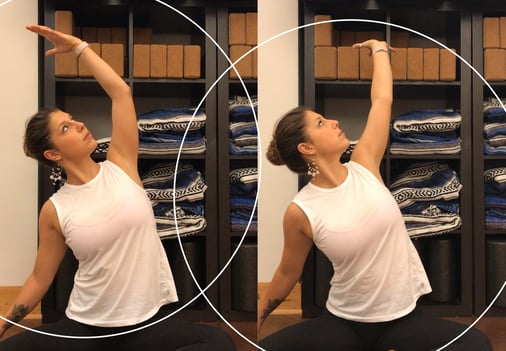
How to do the Oblique Stretch:
Reach. Raise one arm up and then overhead in an arch. It’s UP and then over to elongate the side of your body.
Take 3-5 breaths. Relax your shoulders and stretch your obliques and rib cage by breathing deeply.
Reach your top arm behind you. Gently twist your chest up toward the ceiling.
Flex your fingers back toward your elbow and spread your fingers wide. This will stretch your wrist and forearm.
Repeat on the second side.
Yoga Sequence: Jaw Stretch
Similar to the shoulder stretch, this stretch starts by engaging muscles and then relaxing them to go deeper into the stretch. It is a small movement but should feel like a noticeable stretch in your neck and jaw, where many people tense up while working.

How to do a Jaw Stretch:
Open your mouth as wide as you can.
Tilt your head back and then your neck, keeping your mouth wide open.
Close your mouth, keeping your head back.
Slowly return your head to the center.
Drop your chin to your chest for a counter-stretch if that feels ok with your neck.Yoga Sequence: Eagle Arms
Eagle Pose (Garudasana) creates a tourniquet effect on the shoulders, elbows, and wrists. Think of it as a compression massage on your joints. When that compression is released, new blood and fluids rush back into the area, creating a feeling of openness and relief.
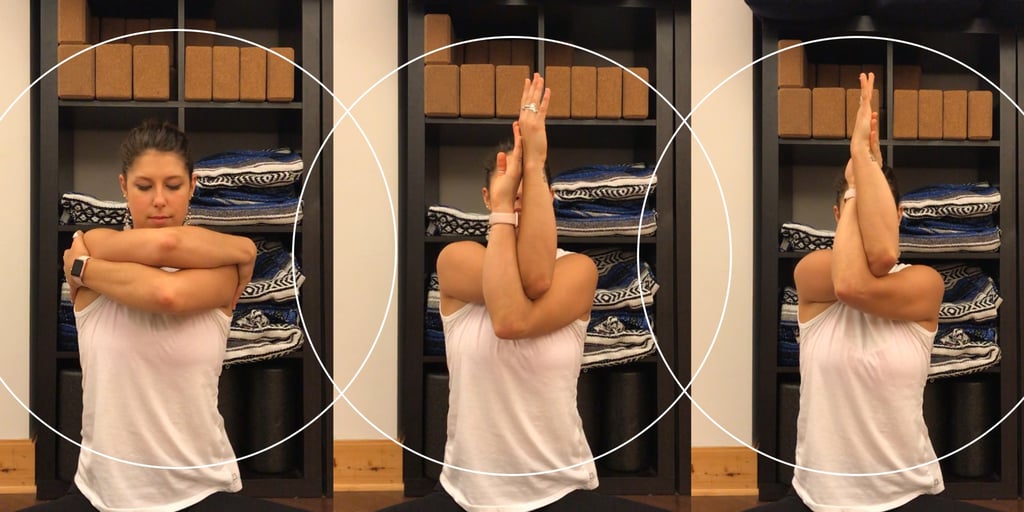
How to do the Eagle Pose:
Level 1: cross one arm on top of the other, like you’re giving yourself a hug. Grab the backs of your shoulders or shoulder blades.
Level 2: Cross one elbow under the other. Bring the backs of your forearms together. Keep your elbows at shoulder height.
Level 3: Cross one elbow under the other. Cross again at the forearms so that the fingers of your bottom arm meet the palm of your top arm. Squeeze your arms together. Keep your elbows at shoulder height.
At any level, you should feel the stretch across your upper back and shoulders.
Yoga Sequence: Eagle Crunches (add-on)
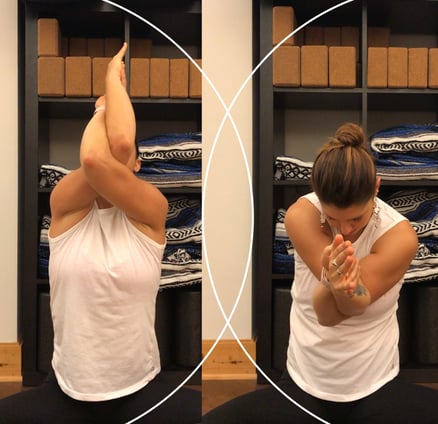
How to do the add-on for the Eagle Crunch exercise:
Lift your elbows, head, and gaze upward. It is a slight backbend.
Slowly crunch your elbows toward your navel, tuck your chin and look down. It is a slight forward fold.
Repeat these two motions, moving slowly between them.
Inhale when you arch back; exhale when you fold forward.
Yoga Sequence: Chest Expansion
The opposite of the Eagle, this pose opens the front side of the chest and shoulders. It is easy to do sitting or standing, and you can even hold on to the back of a chair to deepen the stretch. Remember to keep your front abs engaged so it doesn’t turn into a large backbend—that will take the stretch out of your shoulders and put stress on your lumbar spine.
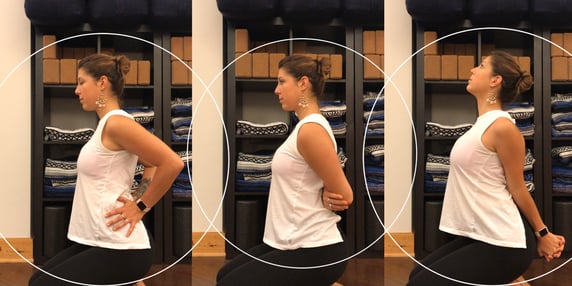
How to do the exercise:
Place your hands on your lower back. Fingers can point down, out, or up.
Squeeze your elbows together.
Relax your shoulders away from your ears.
For more stretch, hold on to the opposite elbow behind your back.
For even more, clasp your hands at your lower back. Squeeze your palms together to touch. Then press your knuckles down toward the ground.
Yoga Sequence: Neck Stretch
This simple pose can be incredibly effective with a few extra tricks. It lengthens the neck, relaxes the jaw, and stretches the top of the shoulder. Adding PNF can take the pose even deeper. Remember to always breathe, go slowly, and soften your tongue and jaw.
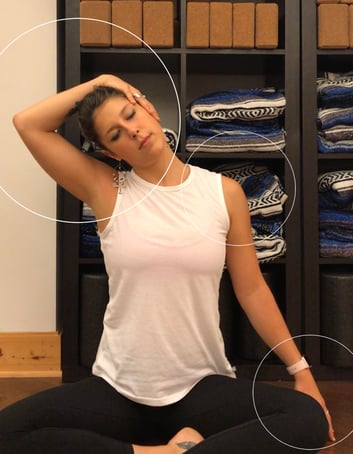
How to do the Neck Stretch exercise:
Reach one hand up over your head and rest it on your opposite ear.
Gently guide your head to the side to stretch your neck. Do not pull; gravity will do most of the work here.
Actively stretch your bottom arm away from you to deepen the stretch.
For PNF (Proprioceptive Neuromuscular Facilitated), press your head into your top hand for three seconds. Completely relax. Then try stretching gently again to see if you can relax deeper into the stretch.
Repeat on the second side.
Check out this helpful infographic of yoga positions to do at your desk.
For more on basic yoga poses and yoga exercises, see our article "Yoga Poses for Grounding and Relaxation" and learn how to deal with stress to achieve emotional well-being.
For coaching support to cultivate inner peace and greater work-life balance, contact us at support@heartmanity.com.





